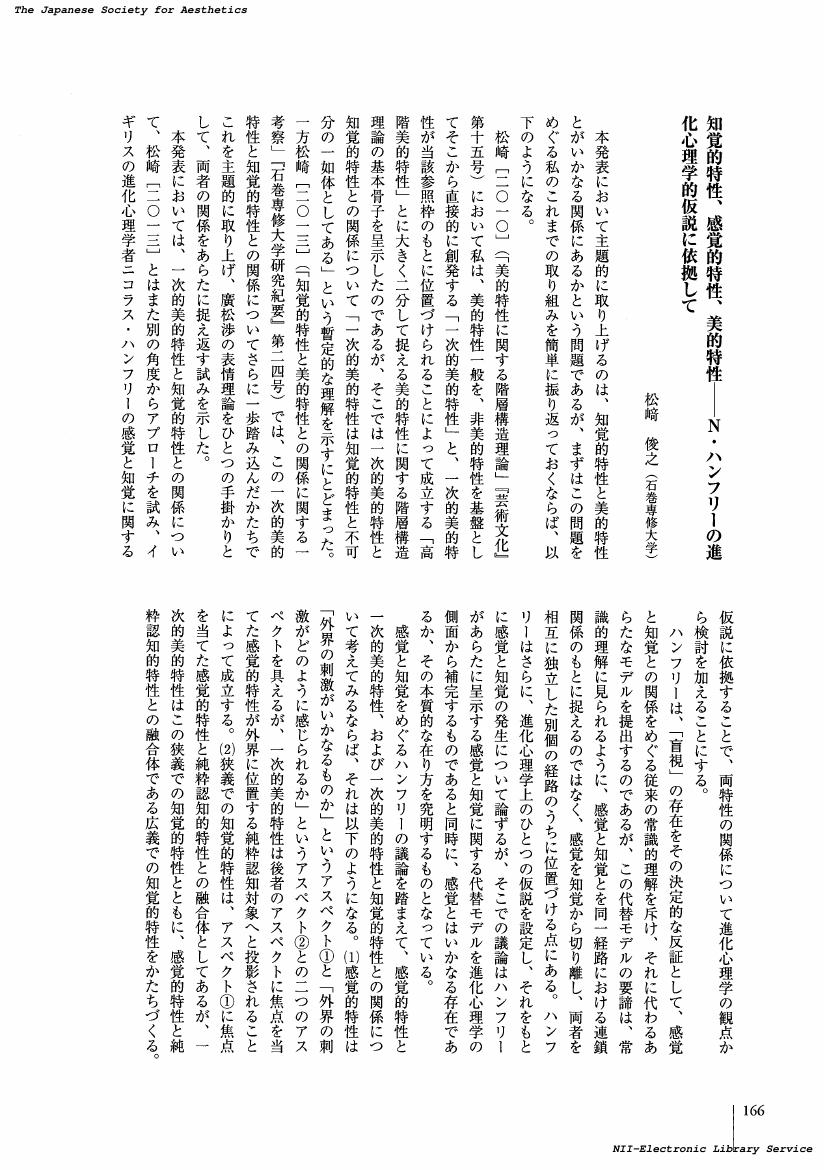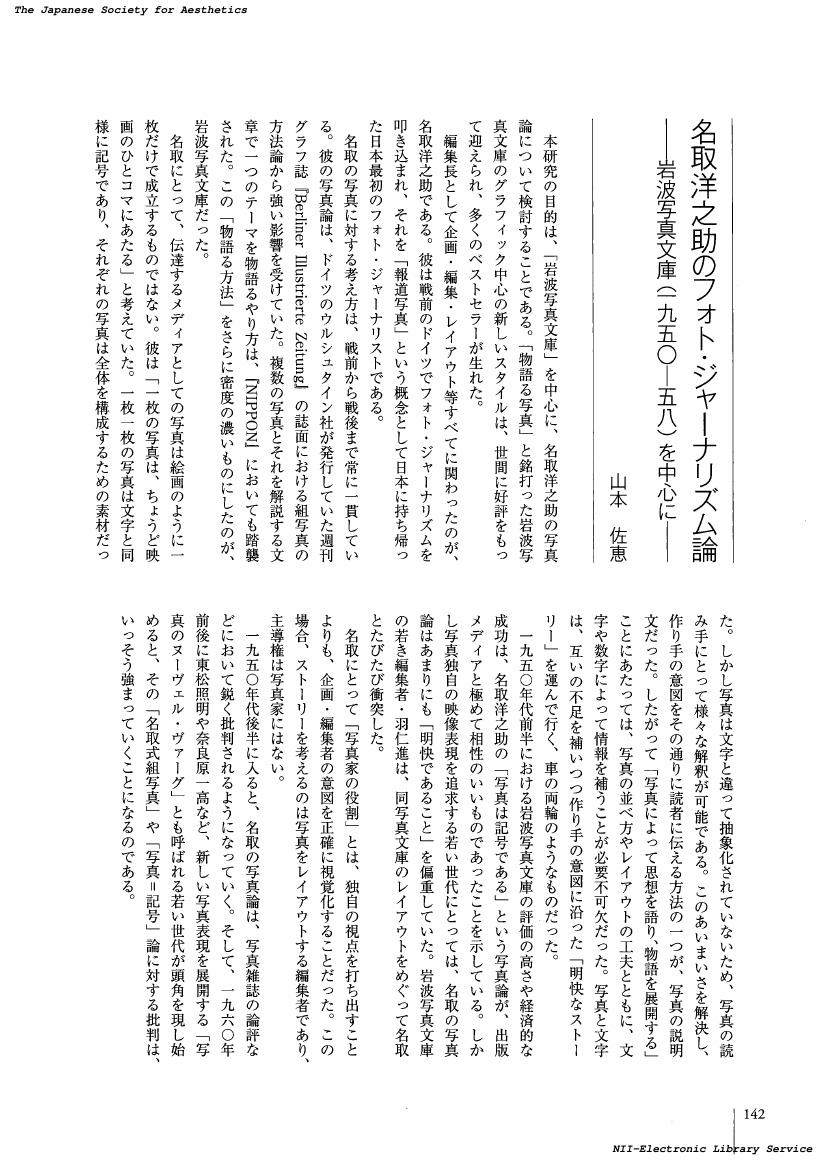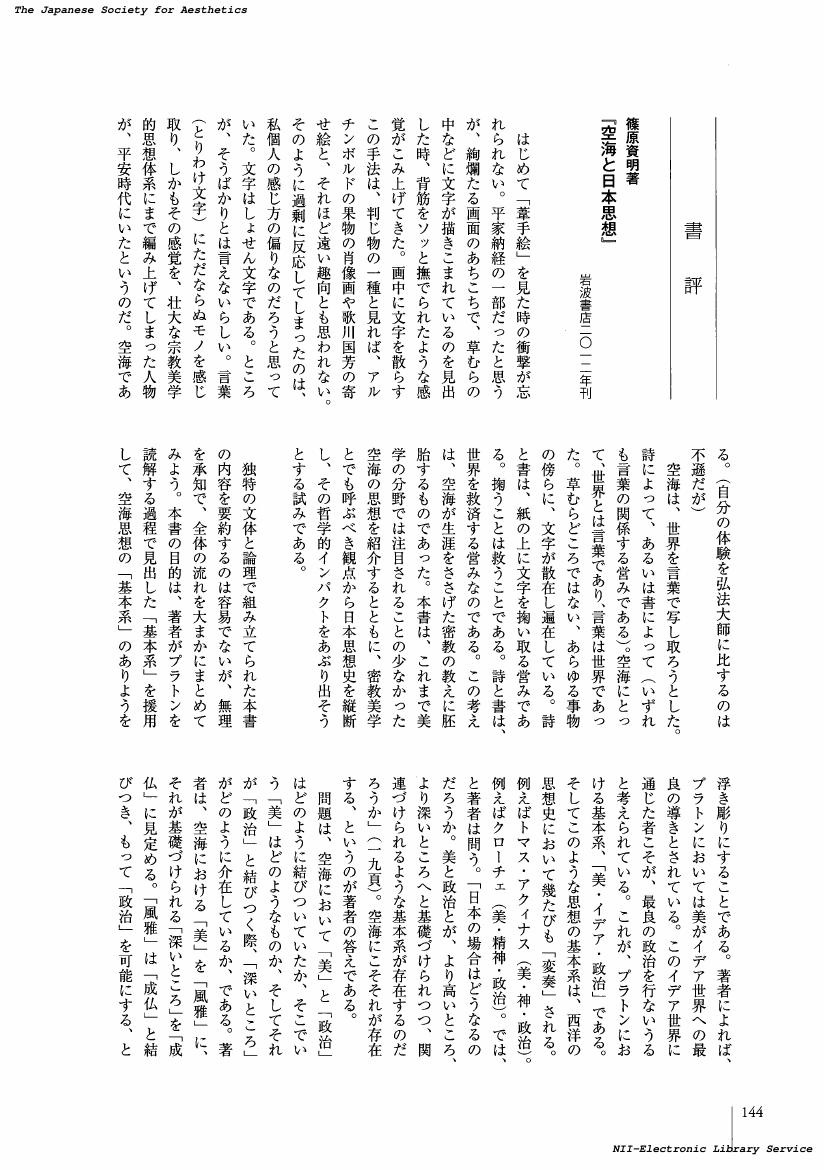1 0 0 0 OA ジョルジュ・バタイユ『マネ』における「沈黙」の様相
- 著者
- 井岡 詩子
- 出版者
- 美学会
- 雑誌
- 美学 (ISSN:05200962)
- 巻号頁・発行日
- vol.65, no.1, pp.25-36, 2014-06-30 (Released:2017-05-22)
L'objectif de cet article est de proposer une nouvelle interpretation du <<silence>> dans Manet de Georges Bataille. Dans Manet, Bataille trouve les deux types de <<silence>> aux peintures de Manet et Goya. D'une part, selon Bataille, le <<silence>> chez Goya est le cri ou le balbutiement : il peut etre interprets comme exces du langage de la peinture. D'autre part, le <<silence>> chez Manet est apporte par une operation de destruction du sujet represente : l'operation est l'utilite et la fonction de la conscience, dans la Theorie de la religion. Cependant, selon Bataille, la fin de l'art n'est pas l'utilite. Pour cela, l'operation de Manet serait de detourner cette fonction de l'utilite, c'est-a-dire d'user cette fonction en tant que jeu. C'est ce que Bataille considere comme art moderne. On peut considerer les deux <<silences>> comme instant ou se presentent les deraisonnables (le cri, le balbutiement et le jeu) dans les raisonnables (le langage de la peinture et la conscience). Bataille respecte l'art comme occasion pour reconnaitre la revolte a l'interieur de la raison.
1 0 0 0 OA 「ローマ文化」の建設 : トラヤヌス記念柱の犠牲式図像に関する一考察
- 著者
- 坂田 道生
- 出版者
- 美学会
- 雑誌
- 美学 (ISSN:05200962)
- 巻号頁・発行日
- vol.65, no.1, pp.37-48, 2014-06-30 (Released:2017-05-22)
The column of Trajan was completed in 113 A.D. to commemorate the victory in the Dacian War. This paper reexamines the meaning of two sacrificial scenes (86, 98-99), which have been interpreted as the pledge for victory. In scene 86, the emperor performs sacrifice in front of a theatre in a harbor, while he pours libation in front of the huge bridge over the Donau allegedly constructed by Apollodorus of Damascus in scene 98-99. Before the reign of Trajan, sacrificial iconographies for the pledge of victory usually have temple architectures in the background, which implies gods the sacrifices are dedicated to. However, in the two scenes, typical roman architectures are represented in the background. I would argue that the two scenes represent not the pledge for victory, but commemorating the completion of typical Roman architectures. Two scenes may also have a meaning of praising Trajan, who completed the great construction in Roman colonies. This characteristics can also be seen not only in other scenes on the column of Trajan such as constructing roads, military camps and bridges, but also in the inscription on the base of the column.
1 0 0 0 OA 追悼の建築としての伝記集 : ヴァザーリ『芸術家列伝』再考
- 著者
- 古川 萌
- 出版者
- 美学会
- 雑誌
- 美学 (ISSN:05200962)
- 巻号頁・発行日
- vol.65, no.1, pp.49-60, 2014-06-30 (Released:2017-05-22)
The lives of the artists, or Vite, written by an Italian painter and architect Giorgio Vasari (1511-1574), has been considered as one of the most important works in art historiography. However, since Vasari has shown the development of artistic styles and the triumph of maniera moderna in this work, a simple fact seems to have been overlooked for quite a long time, that this book is substantially a collection of artists' biographies, rather than an extensive treatise on the history of art. This essay returns to the fact, and attempts to reconsider the structure and purpose of this book. Epitaphs and woodcut portraits of artists contained in Vite are examined to demonstrate how Vasari views these biographies as funerary monuments to assure their eternal fame, making the whole book a temple to house them. Through the analysis, Vite will also reveal itself as a tool to promote Cosimo I de' Medici's artistic patronage. This is achieved by echoing the act of mourning their artists, which was practiced by such people as Cosimo il Vecchio de' Medici and Lorenzo de' Medici, consequently emphasizing the continuity from the Florentine Republic era.
- 著者
- 柳沢 史明
- 出版者
- 美学会
- 雑誌
- 美学 (ISSN:05200962)
- 巻号頁・発行日
- vol.64, no.2, pp.163, 2013-12-31 (Released:2017-05-22)
- 著者
- 今村 信隆
- 出版者
- 美学会
- 雑誌
- 美学 (ISSN:05200962)
- 巻号頁・発行日
- vol.64, no.2, pp.164, 2013-12-31 (Released:2017-05-22)
- 著者
- 鈴木 幸人
- 出版者
- 美学会
- 雑誌
- 美学 (ISSN:05200962)
- 巻号頁・発行日
- vol.64, no.2, pp.165, 2013-12-31 (Released:2017-05-22)
- 著者
- 松崎 俊之
- 出版者
- 美学会
- 雑誌
- 美学 (ISSN:05200962)
- 巻号頁・発行日
- vol.64, no.2, pp.166, 2013-12-31 (Released:2017-05-22)
- 著者
- 安部 孝典
- 出版者
- 美学会
- 雑誌
- 美学 (ISSN:05200962)
- 巻号頁・発行日
- vol.64, no.2, pp.167, 2013-12-31 (Released:2017-05-22)
- 著者
- ディアズ・サンチョ イヴァン
- 出版者
- 美学会
- 雑誌
- 美学 (ISSN:05200962)
- 巻号頁・発行日
- vol.64, no.2, pp.158, 2013-12-31 (Released:2017-05-22)
- 著者
- 水田 百合子
- 出版者
- 美学会
- 雑誌
- 美学 (ISSN:05200962)
- 巻号頁・発行日
- vol.64, no.2, pp.159, 2013-12-31 (Released:2017-05-22)
- 著者
- 山下 晃平
- 出版者
- 美学会
- 雑誌
- 美学 (ISSN:05200962)
- 巻号頁・発行日
- vol.64, no.2, pp.160, 2013-12-31 (Released:2017-05-22)
- 著者
- 宇多 瞳
- 出版者
- 美学会
- 雑誌
- 美学 (ISSN:05200962)
- 巻号頁・発行日
- vol.64, no.2, pp.161, 2013-12-31 (Released:2017-05-22)
- 著者
- 西木 政統
- 出版者
- 美学会
- 雑誌
- 美学 (ISSN:05200962)
- 巻号頁・発行日
- vol.64, no.2, pp.162, 2013-12-31 (Released:2017-05-22)
- 著者
- 弥園 綾奈
- 出版者
- 美学会
- 雑誌
- 美学 (ISSN:05200962)
- 巻号頁・発行日
- vol.64, no.2, pp.141, 2013-12-31 (Released:2017-05-22)
- 著者
- 山本 佐恵
- 出版者
- 美学会
- 雑誌
- 美学 (ISSN:05200962)
- 巻号頁・発行日
- vol.64, no.2, pp.142, 2013-12-31 (Released:2017-05-22)
1 0 0 0 OA イメージと時間 : ドゥルーズのイメージ論(第六十四回美学会全国大会発表要旨)
- 著者
- 渡辺 洋平
- 出版者
- 美学会
- 雑誌
- 美学 (ISSN:05200962)
- 巻号頁・発行日
- vol.64, no.2, pp.143, 2013-12-31 (Released:2017-05-22)
1 0 0 0 OA 篠原資明著, 『空海と日本思想』, 岩波書店, 二〇一二年刊
- 著者
- 玉村 恭
- 出版者
- 美学会
- 雑誌
- 美学 (ISSN:05200962)
- 巻号頁・発行日
- vol.64, no.2, pp.144-147, 2013-12-31 (Released:2017-05-22)
1 0 0 0 OA 森田亜紀, 『芸術の中動態:受容/制作の基層』, 萌書房, 二〇一三年
- 著者
- 貫 成人
- 出版者
- 美学会
- 雑誌
- 美学 (ISSN:05200962)
- 巻号頁・発行日
- vol.64, no.2, pp.148-150, 2013-12-31 (Released:2017-05-22)
- 著者
- 松丸 久美
- 出版者
- 美学会
- 雑誌
- 美学 (ISSN:05200962)
- 巻号頁・発行日
- vol.64, no.2, pp.151, 2013-12-31 (Released:2017-05-22)
- 著者
- 太田 智己
- 出版者
- 美学会
- 雑誌
- 美学 (ISSN:05200962)
- 巻号頁・発行日
- vol.64, no.2, pp.156, 2013-12-31 (Released:2017-05-22)
















